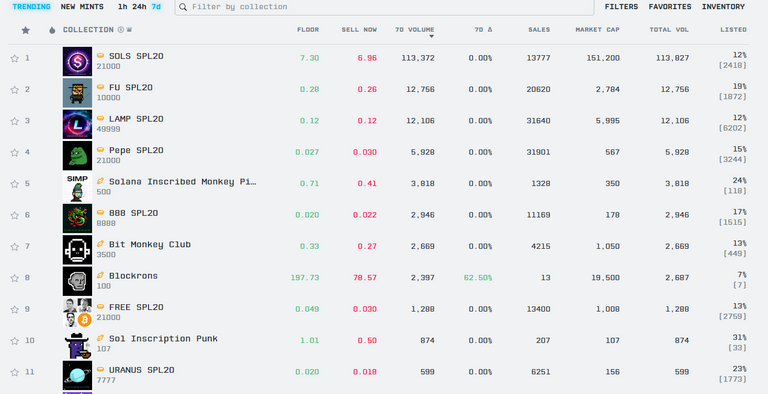1.Inscription
Inscription is a novel NFT creation method on the Solana blockchain that enables users to directly mint NFTs from digital images without requiring code or external tools. It simplifies the NFT creation process, making it more accessible to a broader audience.

Advantages
- Simplicity: Inscription eliminates the need for complex coding or external tools, making NFT creation accessible to non-technical users.
- Efficiency: Inscription streamlines the minting process, reducing the time and effort required to create NFTs.
- Cost-Effectiveness: Inscription minimizes the minting costs associated with creating NFTs.
Weaknesses
- Limited Customization: Inscription offers less customization compared to traditional NFT creation methods.
- Emerging Technology: Inscription is a relatively new technology, and its long-term implications are still being explored.
Features
- Direct Image Minting: Allows direct minting of NFTs from digital images.
- Streamlined Process: Simplifies the NFT creation process for non-technical users.
- Cost-Effective Minting: Reduces the minting costs associated with NFT creation.
Utilities:
- Accessible NFT Creation: Enables a broader range of users to create and participate in the NFT ecosystem.
- Simplified NFT Minting: Streamlines the NFT creation process for various applications.
- Cost-Effective Digital Art Creation: Provides a cost-effective way to create and own digital art.
2.pNFT (Programmable NFT)
pNFTs are an advanced form of NFT that extends the functionality of traditional NFTs by incorporating code or instructions. This allows pNFTs to behave in dynamic and customizable ways, expanding their potential applications.
Advantages
- Customizable Behavior: pNFTs can be programmed to behave in specific ways based on user interactions or external events.
- Enhanced Functionality: pNFTs can interact with other dApps and smart contracts, enabling more complex applications.
- Scalability and Flexibility: pNFTs provide a more scalable and flexible framework for NFT development.
Weaknesses
- Increased Complexity: pNFTs require more technical expertise to develop and implement compared to traditional NFTs.
- Potential Security Risks: The additional functionality of pNFTs may introduce new security vulnerabilities.
- Standardization Challenges: The lack of standardization for pNFTs can hinder interoperability and adoption.
Features
- Customizable Logic: pNFTs can store code or instructions that execute upon interaction.
- Data Storage Capability: pNFTs can store additional data, such as metadata or user-generated content.
- Interoperability with dApps: pNFTs can interact with other dApps and smart contracts on the Solana blockchain.
Utilities
- Interactive Gaming: pNFTs can create more engaging and dynamic gaming experiences.
- Decentralized Finance (DeFi): pNFTs can facilitate the creation of decentralized financial instruments.
- Supply Chain Management: pNFTs can enhance supply chain transparency and efficiency.
- Dynamic Digital Art: pNFTs enable the creation of interactive and evolving digital art forms.
3.cNFT (Compressed NFT)
cNFTs are a type of NFT that utilizes compression algorithms to reduce the file size of NFT data. This optimization aims to address storage and bandwidth limitations, making NFTs more accessible and scalable.

Advantages
- Reduced File Size: cNFTs significantly reduce the file size of NFTs, minimizing storage and bandwidth requirements.
- Faster Transfers: cNFTs facilitate faster NFT transfers due to their smaller file size, improving transaction efficiency.
- Cost-Effective Storage and Transfers: cNFTs can reduce the storage and transfer costs associated with NFTs.
Weaknesses
- Data Loss Potential: Compression may introduce some loss of data quality, which may be unacceptable for certain use cases.
- Limited Compatibility: cNFTs may not be fully compatible with all NFT marketplaces and wallets.
Features
- Compressed Data Format: Utilize compression algorithms to reduce file size.
Efficient Storage and Transfers: Minimize storage and bandwidth requirements for NFTs. - Reduced Costs: Lower storage and transfer costs associated with NFTs.
Utilities: - Accessible NFT Storage: Enable more efficient and affordable NFT storage solutions.
Scalable NFT Ecosystem: Facilitate the growth of the NFT ecosystem by reducing storage and bandwidth constraints. - Cost-Effective NFT Applications: Allow for more cost-effective utilization of NFTs in various applications.